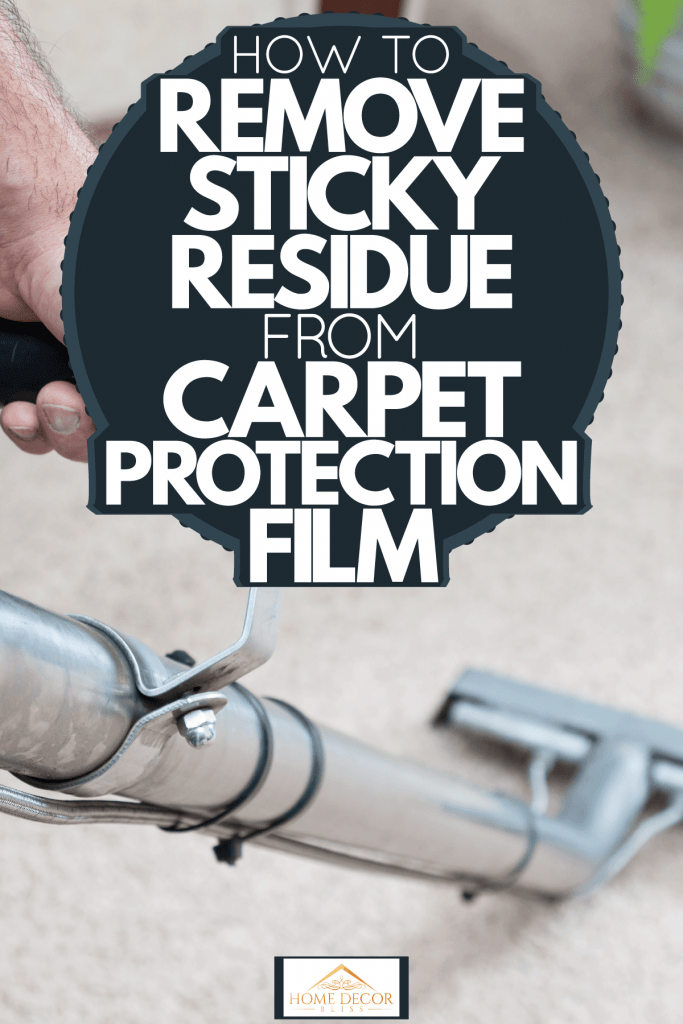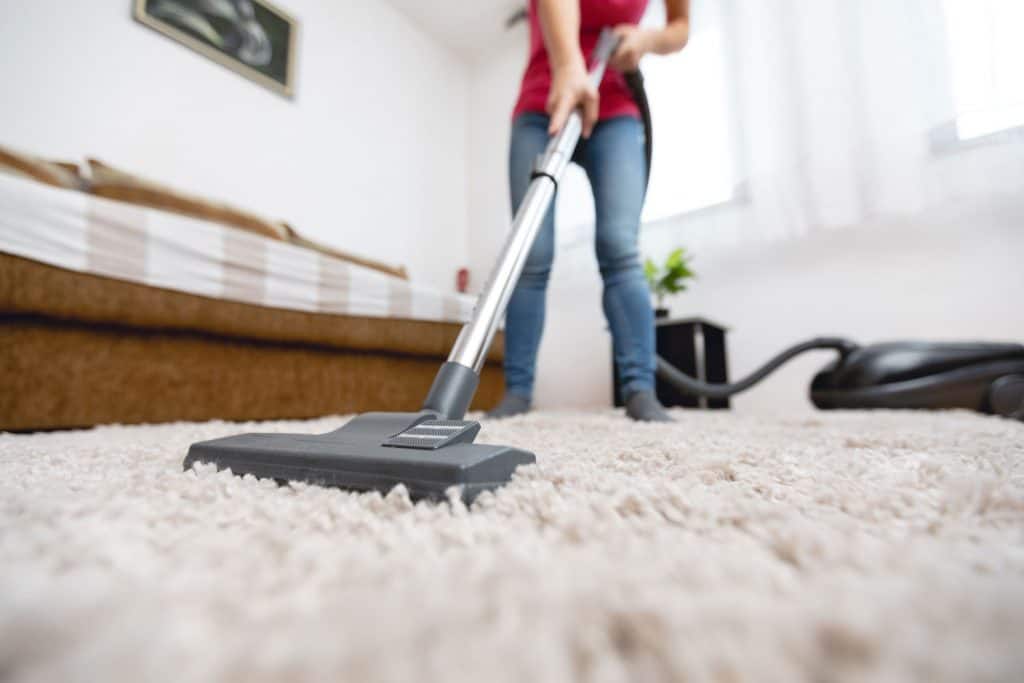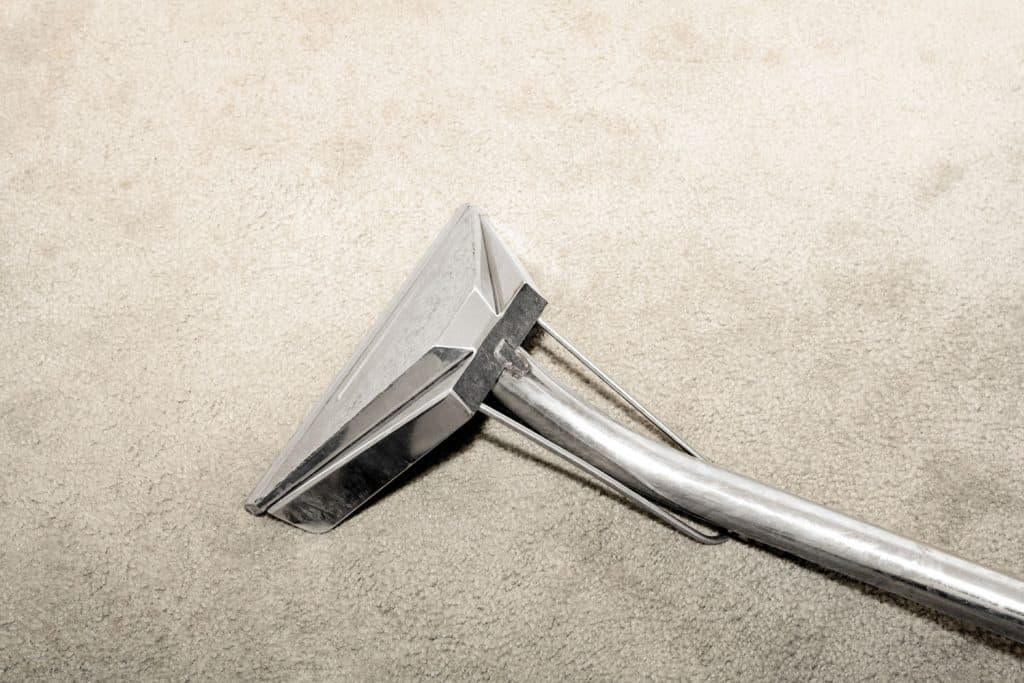If you applied carpet film protection to your carpet flooring and are now looking for techniques for removing sticky residue from carpet protector film, you’ve come to the right place! We will explore home remedies and various commercial adhesive removers to help you remove the leftover adhesive from your carpets in no time.
The first step to removing adhesive from the carpet is knowing whether it is water-based or solvent-based. You can find the type on the product packaging or the company’s website. If the adhesive is water-based, use a steam cleaner or warm water to remove it from the carpet. If it is solvent-based, you will require a citrus-based cleaner.
Don’t worry if adhesive sticks on your carpet when it’s time to remove the protective film! Removing the adhesive is easy when you know what to do. For a comprehensive guide on removing sticky residue from carpet protection film, keep reading ahead.

How To Remove Sticky Residue from Carpet Protection Film
Adhesive carpet films are quite a practical innovation for time-saving cleaning when you renovate your house or do any work that might ruin the carpet. Many commonly use it on construction work, housing projects, showcasing property for sale, or any other activity that might lead to the carpet getting dirty or worn out.
It is also present on rugs and spaces such as car interiors, boats, buses, or any other heavy traffic areas that contain some carpeting. These protection films are versatile and getting increasingly popular. Carpet protectors are easy to apply. The process is pretty quick. These films are self-adhesive and apply directly on the carpet with an extremely practical reverse-wound.
The film peels away after you’re done with the messy work, leaving your carpets good as new! If used according to the instructions provided by the manufacturer, protective plastic films for carpets should be pretty efficient.
However, adhesive can transfer from the protective film to the carpet due to numerous reasons such as intense heat, prolonged use of the film, heavy foot traffic, etc. It is pretty easy to remove this adhesive from your carpets.
Small Patch vs Large Patch of Adhesive on the Carpet
After removing the protective film, you may have small patches of adhesive left behind. You can remove the remains with some elbow grease and friction. For a larger area, you will have to use either a steam cleaner or a citrus-based cleaner according to the type of adhesive on the carpet protection film.
How to Get Your Hands on a Steam Cleaner

We may include affiliate links and curated AI content to highlight top design styles.
You can rent steam cleaners from your local hardware store. Skip on the expensive bills you might have to pay if you call professional carpet cleaners with steam cleaning equipment to your home. You can opt to rent out the machine from the store and get to work yourself. It might seem a bit overwhelming, but it’s easier than you might think.
Citrus-Based Cleaners for Solvent-Based Adhesive
You can clean solvent-based adhesive with steam cleaning machines as well. But, you might have to do it a couple of times before you can remove all of it entirely. A citrus cleaner is far more efficient than a steam cleaner when cleaning solvent-based adhesive from carpets.
The following are some simple steps to follow in order to successfully remove solvent-based adhesive from your carpet using a citrus cleaner:
- Buy a citrus-based cleaner that specifies that it is specialized for removing adhesive.
- Carefully read the instructions written on the cleaner’s packaging before use. This step is essential because you need to dilute some cleaners before applying them to a carpet. If you're not careful, your carpet might get even messier.
- You might want to test the prepared cleaner on an extra patch of carpeting in an obscure area that will be out of sight if things don’t go as planned.
- Fill a spray bottle with the cleaner, or as instructed, prepare the cleaner for use.
- Using a cloth or towel, wipe the cleaner and adhesive clean. You might have to blot or scrub the carpet a bit if the adhesive is stubborn or doesn’t make its way through the carpet fiber.
If you use a steam cleaner, you will still have to perform a patch test on an obscure patch of carpeting. Let the wand of the steam cleaner heat up to the suggested temperature (usually between 170-190 degrees Fahrenheit). However, if you fear that you might make things messier, it is okay to call professional carpet cleaning companies that cater to adhesive removal services.
For more information on removing adhesives, check out our post here.
How Do You Use Carpet Protector Films?
Click here to see this carpet protector film on Amazon.
You can apply the carpet protector film by hand or using a film dispenser. It depends on the area that you wish to cover and also the accessibility to the carpet. It is easier to stick down the film by hand if there is a lot of furniture or if the area is difficult to reach with a dispenser.
How To Remove a Carpet Protection Film
It is simple to remove the carpet protection film after use. Pry up the film from one end and start peeling away as you would peel tape. Don’t pull too fast or too slow. Maintain an average speed and make sure that it is consistent so that there is little adhesive left behind.
Do Plastic Carpet Protectors Work?
What you can and cannot do should be mentioned in the instruction manual. Follow these directions carefully to avoid any mishaps. Here is a simple guide on how to use carpet protector films of any kind:
- Make sure that your carpet is completely dry. Even a bit of dampness can cause color-fading when the adhesive reacts with the moisture.
- Also, make sure that you don’t use carpet protector film on a freshly laid glued-down carpet. Let it breathe for at least three days before covering it with protector film. Glue produces gases that need to evaporate. Otherwise, they might get stuck under the plastic film.
- Choose a carpet protector film with water-based adhesive. They are easier to work with and quickly remove from carpets without a hassle.
- Test the film on a patch of carpet first and see how well it sticks and how easy to remove it is. You will limit the negative results to the tested area alone. This way, you can save yourself from a lot of frustration and cost.
- Shorten the span of use if the weather has a high temperature. Adhesive can melt and get stuck to the carpet in hot weather. Shorten the duration of the recommended application by 50% in the summers.
If you follow these simple instructions, you will find carpet protector films helpful and practical. When applied correctly, they can have additional benefits. It will be stain-resistant and will handle wear more efficiently.
How Do You Flatten a Plastic Carpet Protector?

While you apply the film, you can also go through the flattening process. Pull on the roll to ensure that there is no air trapped under the film. This way, the film is nice and tight before you lay it on the carpet.
If the film still isn’t flat, you can use a knee kicker to flatten it out. Start “kicking” one edge into the place. Place the head of a knee kicker on the carpet at a 90-degree angle to the wall. Then hold the kicker firmly and drive your knee into the base of the knee kicker to push the carpet toward the wall.
Alternatively, you can use a flat object such as a bat or a board to move along the film and apply pressure on it as you glide it along the area.
How Long to Keep a Carpet Protector Down?
The carpet protection film rolls will have instructions that specifically mention the maximum number of days the film can be placed on the carpet before things start going southwards. This duration will probably vary from a month to forty-five days, depending on the brand and quality of carpet protective film.
Remember to cut down the duration by 50% in hot weather! Adhesive can melt during increased temperatures and is more likely to stick to the carpet.
Can You Put a Carpet Shield on Hardwood Floors?
Some suggest not using any adhesive on wooden floors. Try products that specify in protecting hardwood surfaces. Products like rubber sheets have non-slip backs that are reusable and.
They are worthwhile investments when it comes to hardwood floor protection. These products are even waterproof, absorbent, and constructed using durable material.
Final Takeaway
Removing sticky residue is always a burdensome task. While it may seem like a simple task, in reality, it feels like it takes centuries to finish. However, with a little bit of research, you can make the process simpler! We hope you found the information above insightful and informative.
Before you go, do you have other carpet concerns? Do you wonder if the carpet should go under the baseboard? We have the answer! For more information, check out our post here.




